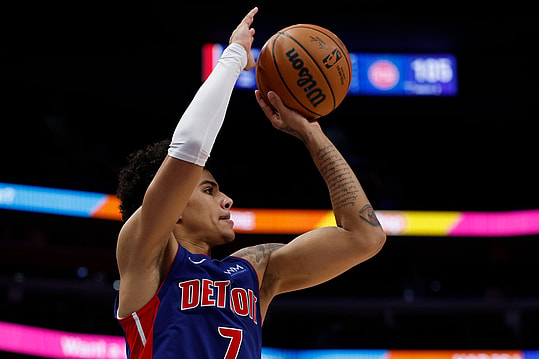
The Brooklyn Nets aren’t done tinkering with their roster with news coming out that they have signed point guard Killian Hayes, the seventh overall pick of the 2020 NBA draft. We already broke down a lot of what Hayes could bring to the table when the Nets attended his workout a couple of weeks ago, but now we’ll break down exactly how he fits and what it means for Brooklyn.
Nets sign Killian Hayes to an Exhibit 10 deal

The deal signed by Hayes and the Nets is an Exhibit 10 contract, which essentially means Hayes is only guaranteed a try-out with the team during training camp. The nature of Exhibit 10 contracts, first introduced in 2017, gives teams options. Non-guaranteed to start, Hayes’ contract would convert to a standard one-year minimum salary if Hayes remains on the team after training camp. The Nets could also assign him to the G-League, or be converted into a two-way contract at which point only his bonus would become guaranteed. This type of flexibility is perfect for a reclamation project.
Killian Hayes has some intriguing skills
Hayes’ biggest strength that has been demonstrated consistently in the NBA is his ability as a point-of-attack defender. As a bigger guard standing at 6-5 with a 6-foot-8-inch wingspan he’s able to defend either guard position as well as some wings, while also being disruptive in the passing lanes.
Offensively, he’s a natural point guard who does excel as a passer. Last season, he ranked 11th in the league in passer rating, a measure that determines the efficiency and effectiveness of a player’s passes, according to CraftedNBA. Despite playing a career-low 24 minutes per game last season, he averaged 4.9 assists and a career-low 1.2 turnovers per game, highlighting his ability to set up teammates while simultaneously taking care of the ball.
Unfortunately, Hayes is a brutal shooter. Owner of career 38.2% field goal percentage and shooting 27.7% from three on 2.9 attempts per game, he negates all of the positive value he generates as a passer. If there is a silver lining, his percentages improved to career bests of 41.3% overall and 29.7% from three last season, although those are still very subpar results.
Hayes’ potential fit on the roster

Even after signing Summer League standout Keon Johnson to a multi-year contract, the Nets were thin at guard, especially needing true point guards. Prior to the Hayes addition, only veterans Dennis Schroder and the oft-injured and perpetually unavailable Ben Simmons served as true floor generals on the roster.
Moreover, Hayes’ defensive ability fits nicely next to budding young star, Cam Thomas, who has been an exceptionally poor defender throughout his young career. Playing alongside Hayes would allow Thomas to take on easier defensive assignments while still serving as an electrifying scorer on the offensive end. Frankly, if Hayes could shoot the three with some efficiency, he’d be a picture-perfect fit alongside Thomas.
There is some hope for the future
The Nets have had luck turning young castoffs into productive NBA players in the past. Some organizations excel at player development, while others flounder. In particular, the Nets have had success with two guard reclamation projects that were originally discarded by the Detroit Pistons in Spencer Dinwiddie and Bruce Brown.
Dinwiddie in particular is an apt comparison to Hayes as a taller point guard who struggled to shoot the basketball with efficiency. During his first stint with the Nets, he managed to improve his efficiency to the point that he was a solid contributor, while still relying on his size and athleticism which were his biggest strengths. As for Brown, the Nets allowed him to embrace what he did well while minimizing his weakness, outside shooting, until he gained enough confidence to become at least a low-volume outside shooter.
Neither of the aforementioned players had the same pedigree as Hayes, who just turned 23. Both Dinwiddie and Brown were second-round picks whereas Hayes was a consensus lottery pick before the Pistons selected him early in the first round. Given his youth and potential, he’s a worthy flier in a developmental year alongside other first-round busts, the aforementioned Keon Johnson, and recently acquired Ziaire Williams.
Neither Hayes, Williams, nor Johnson need to become the stars they were drafted to be. In a new environment and without past expectations, if any of them become a solid NBA rotation player then the dart throws by general manager Sean Marks will have been a huge success. In any case, these are all no-risk moves that demonstrate quality processes in team building.
More about: Brooklyn Nets